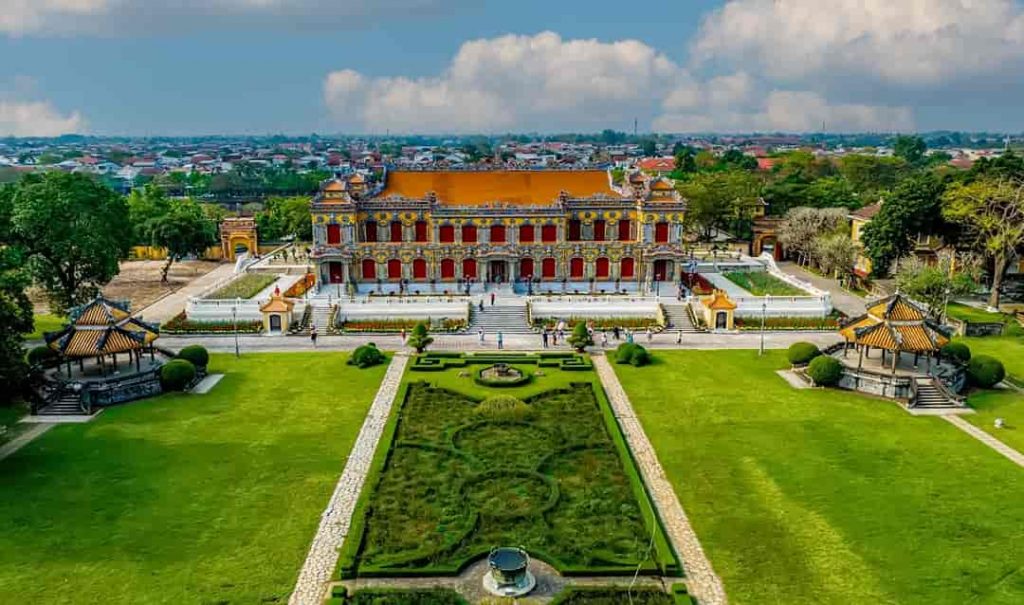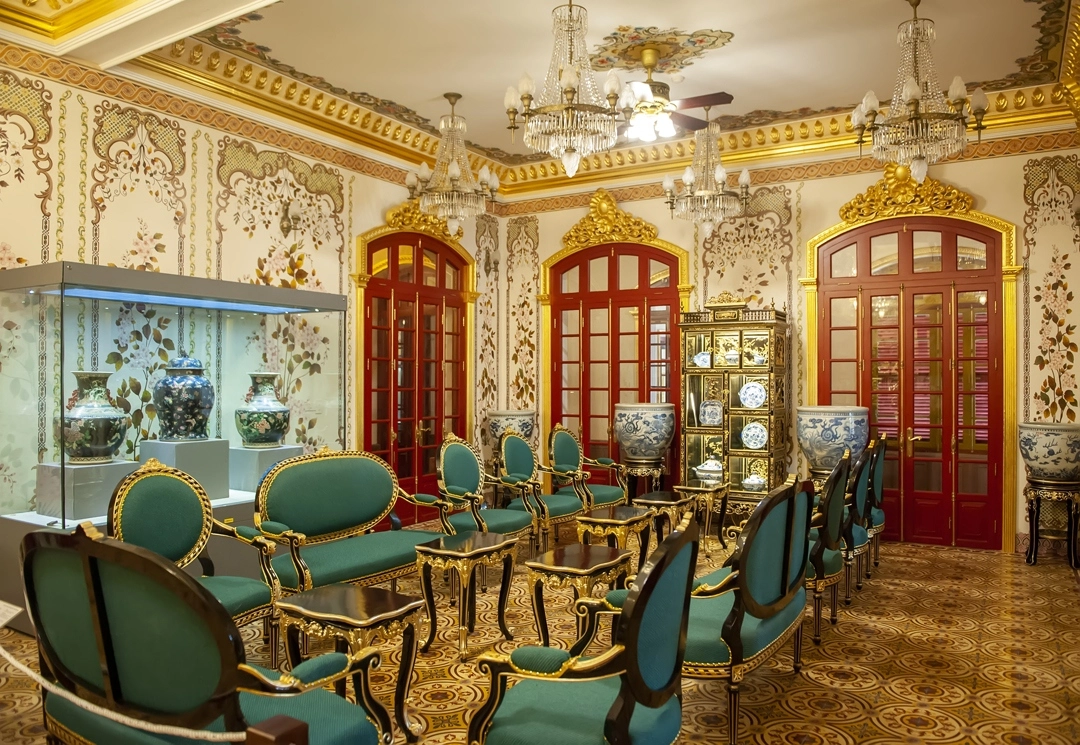Kien Trung Palace used to be the most magnificent palace in the imperial capital of Hue, Vietnam. Over the years, although only the foundation remains, the immense historical and cultural value that this structure brings is still intact as it was originally. Currently, this palace is undergoing restoration, rehabilitation, and enhancement processes.
Table of Contents
Introduction to Kien Trung Palace
- Address: 32 Dang Thai Than Street, Phu Hau Ward, Hue City.
- Opening Hours: 7:30 AM – 5:30 PM daily
- Ticket Prices (updated as of 2024):
- Adults & Foreigners: 200,000 VND per ticket
- Children < 1.3m: 40,000 VND per ticket
Kien Trung Palace is also known as Kien Trung Pavilion. It is the most splendid palace of the Nguyen Dynasty preserved to this day within the area of the Imperial City, part of the Hue Citadel heritage complex. The construction of the palace commenced in February 1921, serving as the working place for the last two kings of the Nguyen Dynasty, Bao Dai and Khai Dinh.

Almost entirely destroyed in 1946, Kien Trung Palace has undergone meticulous restoration efforts by the Hue Imperial City Conservation Center and the Central Region Institute of Science and Technology in Construction. Currently, the palace is in its final stages of completion.
Directions to Kien Trung Palace
Kien Trung Palace is located approximately 2.7km from the city center of Hue, taking less than 10 minutes to travel. Therefore, you can get here by various means of transportation such as taxi, bus, motorbike, car, etc., depending on your needs and personal conditions.
As for the route, from the city center, DanangPrivateCar.com suggests you go towards Phu Xuân Bridge, then turn left onto Lê Duẩn Street – right onto Cửa Ngăn Street – 23 Tháng 8 Street – Đoàn Thị Điểm Street. Then drive along Cửa Quảng Đức Street to reach the Imperial City area of Hue – where Kien Trung Palace is located.
Additionally, if you are looking for a quick and convenient option, you can immediately book a private car rental service with a driver in Hue from DanangPrivateCar.com. With a team of professional drivers with many years of experience, understanding the traffic in Hue, they will help you have the fastest journey. Furthermore, with our private travel car service, we can help you move to other places such as Thien Mu Pagoda, royal tombs in Hue, etc., ensuring you have a private and comfortable trip.
Kien Trung Palace, the majestic structure of the ancient capital of Hue
History of Kien Trung Palace
In 1827, King Minh Mang initiated the construction of Minh Vien Pavilion on the land where Kien Trung Palace now stands, with a total height of about 10.8 meters. By the time of King Tu Duc, this structure was completely destroyed.

In 1919, King Duy Tan mobilized labor to build Du Cuu Pavilion on this site. During the reign of King Khai Dinh, the Du Cuu Pavilion area was expanded to build a palace and named Kien Trung. This was the main residence of the king within the imperial citadel.

In 1932, King Bao Dai renovated the interior of this palace, installing some modern conveniences from the West, including bathtubs. After the August Revolution, Kien Trung Palace became a witness to the event of King Bao Dai meeting with the Provisional Government delegation to discuss abdication.
By 1947, due to the impact of war, the palace was completely destroyed, leaving only the foundation for the reconstruction process later.
Location and Architecture
In terms of feng shui, Kien Trung Palace is located at the northernmost point of the celestial axis passing through the center of the Imperial City. The combination of Renaissance Italian architecture, French architecture, and the characteristic features of ancient Vietnamese structures brings a unique and exquisite beauty to the palace.
In terms of architecture, in front of Kien Trung Palace is a scenic garden with a system of three beautifully sculpted dragon staircases leading up to the palace terrace. The facade is adorned with prominent colorful ceramic pieces.

The main floor consists of 13 open doors, with the central space having 5 doors, and each side space having 3 doors, with two corner spaces on each side having 2 doors. All are designed to protrude outward.
The upper floor of the palace is the attic, with architecture similar to the main floor. At the top is a tiled roof with decorative balustrades in the traditional Vietnamese style.
The beauty of Kien Trung Palace after complete restoration is captivating
In 2019, the Hue Imperial City Conservation Center launched a project to restore Kien Trung Palace, with a total budget of over 123 billion Vietnamese dong. After several years of restoration, the palace is now ready to open its doors to the first visitors during the Tet holiday in 2024.
On February 6, 2024, Mr. Hoang Viet Trung, Director of the Hue Imperial City Conservation Center, announced that the restoration project for Kien Trung Palace had completed 100% of the construction volume.

Below are some images after the completion of the restoration of Kien Trung Palace. This is one of the hottest destinations in Hue, welcoming tourists from both domestic and international destinations.






Tips for visitors
- Kien Trung Palace is located within the complex of Hue Imperial City. Therefore, you can combine visiting the palace with many other outstanding architectural works such as Ngo Mon Hue, Thai Hoa Palace, Dien Tho Palace, etc.
- Because Hue Imperial City is very large with many attractions, DanangPrivateCar.com recommends bringing a map in your backpack to avoid getting lost.
- Prioritize wearing appropriate and historically suitable attire when visiting historical sites.
- Read and adhere to the regulations here, especially for some sites that do not allow interior photography or touching artifacts.
- Pay attention to maintaining cleanliness and dispose of trash in the designated areas.
With its significant historical, cultural, and artistic significance, Kien Trung Palace is considered a symbol of the ancient capital region. It promises to be a tourist destination in Hue that helps you turn back the clock, discover the Nguyen Dynasty – the last feudal dynasty in Vietnamese history, and what remains after many years of ups and downs in the Forbidden City.


Comments